Trigger point trapezius
What is Trigger point trapezius?
The trigger point is raised spots along a band of the muscle. Trigger point trapezius is one of the most common long-term muscle disorders. they can affect anyone. Trigger points trapezius occur in the trapezius muscle. This is a very large back muscle that extends from below the shoulder blades, up to the shoulders, and then along the back of the neck. You may be able to feel the elevated spots in the muscle. They may feel like a knot in the upper back, the shoulder, and/or the neck. The trigger points are may feel especially painful when the therapist touched the painful part, and the pain may radiate beyond the immediate area. and there are two types of trigger points: active and latent.
The trapezius muscle is located on the upper back and primarily moves the shoulders, and the trigger points in this area can be closely linked with headaches and neck pain. There are many trigger points within a trapezius muscle. The trapezius muscle is the large band of the muscles that span the upper back, the shoulders, and the neck. You may develop a trigger point along the band of the trapezius muscle. These are raised parts of the muscle that can be painful part. Trigger points can develop for several reasons, including from inactivity, exercise, or working for prolonged periods with an abnormal or poor posture or with your head down.
A common area of a body susceptible to trigger points is the muscles connecting the shoulders to the neck or the upper trapezius muscles. The Upper trapezius muscles are responsible for keeping your head up straight, rotating the head away, and bringing the ear down to the shoulder or vice versa bringing the shoulder up to the ear. generally when sitting at a computer for long periods of the day the trapezius muscles work to maintain the head position. If your workstation is not suitable you may be increasing the load on these muscles because you are looking down at the screen, particularly the laptop, or your head is rotated slightly to one side more than the other side. Not quite as common nowadays is holding the phone between your ear and your shoulder but if you do this, especially when using a mobile, that is most likely to lead to the development of trigger points in the muscle.
In upper trapezius muscles, the trigger point will produce an aching pain deep in your shoulder blade area and can refer down your arm to the back of your elbow. It may even lead to pins and needles locally. It can also radiate up the skull behind the ear and be responsible for the tension of headaches.
What is a trigger point?
Trigger points are those tender lumps in the muscles that therapists find. They begin small, and you only know they are there when a therapist gently presses them upon them. Over time they can grow to where they are quite substantial but still not causing pain, but will eventually start shooting pain when they are aggravated.
A trigger point is a sore point in a muscle when you push on it or what most people would be called a knot. You know that bit of the muscle when you are rubbing your tight shoulders that just does not feel right and hurts. When a trigger point is very sensitive it can lead to pain without being pressed on and this is a major cause of muscular pain that most people suffer from. The trigger points are a ‘hypersensitive nodule within a taut band of tissue that can be referred to as pain’.
Trigger points radiate pain to the affected area when pressure on sensitive points in the muscles is applied to them and sometimes spontaneously with no pressure. and sometimes in seemingly not related body parts. This is called referred pain. Trigger points are discrete, focal, hyperirritable spots situated in a taut band in the skeletal muscles. They produce local pain in a referred pattern and often accompany chronic musculoskeletal disorders.
Acute trauma or repetitive microtrauma may cause the development of stress on muscle fibers and the formation of trigger points. Patients may have regional, persistent pain resulting in a reduced range of motion or movement in the affected muscles. These include muscles used to maintain body posture, like those in the neck, shoulders, and pelvic girdle.
Trigger points may also manifest as tension headache, tinnitus, temporomandibular joint pain, reduce or decrease range of motion in the legs, and low back pain. Palpation of a hypersensitive bundle or nodule of fiber of muscle harder than normal consistency is the physical finding normally associated with a trigger point. Palpation of the trigger point will elicit pain directly over the affected area and/or lead to radiation of pain toward a zone of reference and a local twitch response. many modalities, such as the Spray and Stretch technique, ultrasonography, Transcutaneous electrical nerve stimulation, manipulative therapy, and injection, are used to inactivate trigger points. The trigger-point injection treatment is one of the most effective treatment modalities to inactivate trigger points and provide prompt relief of symptoms.
There are types of trigger points:
An active trigger point: The active trigger point is defined as causing pain when no pressure is placed on them. Active trigger points hurt when you move. and this means they are painful even if you are not massaging them. This is only one of the most common causes of Myofascial pain and it can be experienced in any area of the body. A common example, of active trigger points, is back pain including sciatica, knee pain, neck pain, headaches, and so on. where therapists gently press and the red areas are the referral pain pattern. This helps diagnose where the trigger points are. An active Trigger point is any point that leads to tenderness and referral pain pattern on palpation. Almost always central. Trigger Points are active and some satellite Trigger points are also active but not necessarily all of them.
A latent trigger point: A latent trigger point is a point you gently press on that causes pain and often refers pain to in another area. A Latent trigger points only hurt when someone applies pressure along the raised part of the muscle. This type of trigger point is seen as the precursor to active trigger points. If you have this type of trigger point that gets worse through further strain then they can become active trigger points and that is when you generally feel pain and that need anyone to help you get out of the pain. Inactive or Latent Trigger points can develop anywhere and under fingertips feel like lumps, but they are not painful. It can increase the stiffness of the muscles. It has the potential to be active but is dormant. this trigger point is a dormant (inactive) area that has the potential to act like a trigger point. It may cause weakness of the muscle or restricted movement. These nodules do not lead to pain when touched. They can remain inactive for years and become active when there is stress or trauma.
A secondary trigger point: This is situated in a muscle other than the one that holds the active trigger point. It could be disturbed at the same time as the active trigger point. This is a painful point in the muscle that becomes active when you stress other muscles.
A satellite trigger point: The satellite trigger points are an area where the pain is referred to. For example, if you are to get pain in the shoulder and you found that the trigger point was in the shoulder referring to the elbow, the elbow points would be these types of trigger points. And so you will be also working on these elbow trigger points as they would be involved as well. Primary or Central Trigger Points are those that lead to severe pain locally at the pressure with irradiation according to referred pain map. Generally, they are based around the center of a muscle belly. Secondary or Satellite Trigger Points arise in response to existing central trigger points surrounding the muscles. They usually spontaneously withdraw when the central Trigger point is healed. It can be present in the form of a cluster. This trigger point becomes inactive because it overlaps with the region of another trigger point. This is a painful spot that becomes active because it’s situated near another trigger point.
Active and Passive Trigger Points
There are mainly two types of trigger points that physical therapists treat: active trigger points and passive trigger points. Passive trigger points are simply hurt at their exact location. If you have a painful muscle knot in your calf muscle and someone presses on it, the pain will be felt right where the pressure is on the knot.
An active trigger point refers to pain in another part of your body. If someone presses on an active trigger point in a calf or posterior of the leg. you may feel pain in your leg along with symptoms in your foot.
Regardless of the type of trigger point you have or the fact that we do not fully understand what is happening when trigger points are formed. And you may benefit from your physical therapy to help manage your problem.
Trapezius muscle
The trapezius muscle is a large, triangular, and paired muscle located on the posterior aspect of the neck and thorax. When viewed together, this pair forms a trapezoid or diamond shape, hence its name. The trapezius muscle has many attachment points, extending from the skull and vertebral column to the shoulder girdle. The trapezius muscle helps you move your head, neck, arms, shoulders, and torso. It also stabilizes the spine and helps with posture. Muscle strains can affect the traps and lead to pain and decreased mobility.
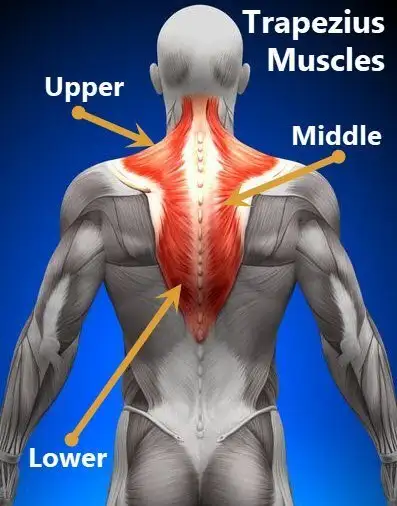
Origin: the medial one-third of the superior nuchal line, external occipital protuberance, nuchal ligament, C7 spine, and supraspinous ligaments of vertebrae T1 to T12.
Insertion: Descending part (superior fibers): the posterior border of the lateral third of the clavicle
Transverse part (middle fibers): medial acromial margin and the superior crest of the spine of the scapula
Ascending part (inferior fibers): on the apex of the medial end of the scapular spine with the bursa intervening.
Innervation :Motor: spinal part of the accessory nerve (CN XI)
Motor/Sensory: anterior rami of spinal nerves C3 and C4 (via cervical plexus)
Action: Upper fibers: elevate the scapula, upwardly rotate the scapula, and extend the neck.
Middle fibers :adduct(retract) scapula,
Lower fibers: Depresses scapula
Blood supply: Occipital artery (descending part), superficial or transverse cervical artery (transverse part), and dorsal scapular artery (ascending part)
A trigger point in the trapezius muscle
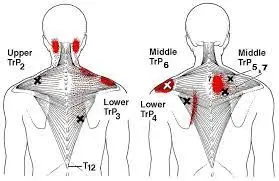
The most common trigger point that develops is the upper trapezius muscle trigger point. Forward head posture is a major contributor to the development of these trigger points. The referral pattern is a pain in the side and back of the neck, behind the ear, and up into the temple.
We are all under stress at a certain period of times of our day and in our lives. When stress occurs, without even knowing what we are doing, we will shrug our shoulders up and wear them like an earring. When we do this, we create tension in the muscles which then leads to trigger points developing.
Other forms of stress placed on the trapezius muscle occur by:
- holding the mobile phone between your shoulder and ear
- putting a heavy purse over your shoulder to carry
- using backpacks
- holding children on the hip with one arm
- sleeping with an arm under your head
- looking at the computer monitor that is located at your right or left, for extended periods
- no arm rests on your chair when working on a computer
- extended activities overhead
- bike riding
- horseback riding
- playing an instrument that requires you to raise your shoulders such as a violin
What are the symptoms of Trapezius Trigger Point?
Trigger points can lead to pain as well as limitations in how you move the muscles. You may notice that pain is close to the site of the trigger point, or that it radiates throughout the muscle.
You may also experience Trigger point trapezius symptoms beyond your muscles, perhaps in the form of:
- a headache
- ear ringing
- jaw pain
- neck tilting
A person coming to see me with active trapezius muscle trigger points may have any and/or all of the following symptoms. depending on how far along their trigger points activity has progressed:
- Headache: The pain will spread to the base of the skull, behind your ear, to the temple, and above your eye. Often this headache pain will exist simultaneously with neck pain.
- Neck Pain and Stiffness: Trapezius trigger point pain generally starts in your neck, along one side. If there is significant stiffness in your neck it typically means that the levator scapula trigger points are involved as well.
- headaches on the temples / “tension” headaches
- facial, temple
- Pain at the Angle of your Jaw: In severe cases, the pain may extend down into your jaw region. This pain can activate other trigger points that contribute to Temporo-mandibular joint(TMJ) disorder symptoms.
- pain behind the eye
- dizziness or vertigo [in conjunction with the sternocleidomastoid (SCM) muscle]
- severe neck pain
- a stiff neck
- limited range-of-motion
- intolerance to weight on your shoulders
- mid-back pain
- headaches at the base of your skull
- TrP5 refers to superficial burning pain close to the spine
- Top of a shoulder Pain or Soreness: In most cases, the neck and headache pain will be preceded by pain, soreness, and a sense of “heaviness” on the top of the shoulder (acromioclavicular) joint. This sensation is produced by the lower trapezius muscle trigger point and is not often noticed by the patient until I remove it by releasing the trigger point. According to a study, most people, this pain is present so much that they learn to ignore it.
- mid-back, neck, and/or upper shoulder region pain
- possibly referral on the back of your shoulder blade, down the inside of the arm, and into the ring and little fingers (TrP7), very similar to the serratus posterior superior referral pattern
- headaches at the base of the skull
- TrP3 can refer to a deep ache and diffuse tenderness over the top of a shoulder
What is referral pain?
Some ideas are suggested that the referral pain if you experience is happening in the brain. It is such as “crosstalk” you get in electrical cables that are close to each other. These can happen in the brain sensation areas in the brain that are close to each other. an eg, if the trigger point is in the gluteus muscle and refers down the leg area of the leg is close to the area in the brain and that is why you feel it there. A few simple ideas are that the muscle may be attached to the area you feel the referral, which is common and may be transmitted through the fascia or nerves.
Referred pain also called reflective pain,( is pain perceived at a location other than the site of the painful stimulus.) Pain is reproducible and does not follow myotomes, dermatomes, or nerve roots. There is no specific joint swelling and/or neurological deficits. Pain from a myofascial Trigger Point is a discrete, distinct and constant pattern or map of pain with no gender or racial differences able to reproduce symptoms – referred pain map. Radiating pain is slightly different from the referred pain. for example, the pain related to a myocardial infarction could either be referred to as radiating pain from a chest. Referred pain is when the pain is located away from and/or adjacent to the organ involved. for instance, when a person has pain only in their left arm or jaw, but not in the chest.
What causes Trigger point trapezius?
TTP occurs for many reasons. Some of the causes include:
- trauma
- repetitive movement
- carrying heavy purses, backpacks, or/and bags on the shoulder
- holding your head forward for too long
- having a preexisting condition in your joints
- moving heavy objects using poor lifting techniques
- not getting enough sleep
- sitting in a chair without proper armrests and back support
- playing sports or engaging in physical activity
- Inactivity
- having a vitamin deficiency
- poor posture
Where is the Trigger point trapezius typically located?
Trigger point trapezius can occur in the back of a neck, along the tops of a shoulder, and in some spots along the shoulder blades.You may experience trigger point pain in another muscle. For eg, trigger points can also occur in the chest, the front of a neck, near elbows, and near the fronts and backs of a knee.
When do I need to see my doctor?
If you notice the pain getting worse or if it affects your daily life or ability to engage in activities like sports or daily exercise, you may need to ask your doctor for help. Soreness or pain in the neck, shoulders, and/or upper back may limit your ability to complete tasks at your job, sleep well, or feel comfortable. Your doctor will examine to diagnose Trigger point trapezius. They will ask about your health history and conduct your physical exam.
This exam will look for changes to the trapezius muscle, such as:
- tightness
- the presence of a nodule
- twitching
How do you treat pain and discomfort caused by Trigger point trapezius?
Most of us carry a lot of tension in the upper trapezius muscle and neck muscles. We experience muscle knots, spasms, or pain located over the muscle between the neck and the shoulder. Typically, most online searches will direct you to self-treat by doing shoulder shrugs, stretching, massaging, or rolling with a lacrosse ball. And if the pain gets worse, medical professionals prescribed oral medications, topical patches, or perform injections with numbing medications or even Botox. However, all of these treatments are minimally effective for a short period because they are not addressing the root of the problem. Instead, you are just treating the pain. Very few people address the cause of upper trap relief because the pathophysiology of the upper trapezius muscle is more complex and therefore difficult to understand and treat compared to other skeletal muscles. Injections and oral medications that cover up the pain temporarily are commonly performed because the results are immediate for a short period and we live in a culture that seeks immediate gratification. Smart and health-conscious healthcare consumers quickly realize that repetitive treatment to fool the brain is not the best way to take care of our bodies.
There are several methods for treating trigger point trapezius. These include medications as well as changes in lifestyle and alternative treatments. A doctor may recommend that you experiment with a combination of approaches to help manage a condition. The sections below will discuss a few of these approaches. Methods for treating Trigger point trapezius include medications as well as a healthy lifestyle and alternative treatments. Lifestyle adjustments. There are several methods you can try at home to reduce Trigger point trapezius pain and discomfort. One simple way to help relieve Trigger point trapezius pain is to apply heat or ice to the affected area. It may also be useful to refrain from regular athletic activities or modify your exercise plan to rest the trapezius muscle for some days or weeks. Stretching and making modifications to your daily activities may also help treat pain and discomfort. For example, one study by a trusted Source found that doing isometric neck exercises three times per day for 15 days, as well as maintaining a better posture, marginally improved discomfort from Trigger point trapezius.
Exercises included:
- circling the shoulders
- extending and bending the neck
- rotating the neck
- There are several exercises you can try to stretch the trapezius muscle.
A few methods to improve posture included avoiding rubber pillows, sitting in chairs with good back support and proper armrests, and sitting upright while working on a computer. You can also try some exercises.
The study also recommended that participants get up from their desks, and every 20 to 30 minutes to stretch and walk around.
Apply heat or ice to the affected areas or parts.
Medical treatments
Non-steroidal anti-inflammatory drugs(NSAIDs) are often prescribed for the initial stage of acute injury. In severe cases that involve multiple joint regions, muscle relaxants or oral steroids can be given. Trigger point injections, steroid injections, or botox can be treatment options. Pain management is not generally required unless stronger medications or joint injections are required for treatment. A doctor may recommend an oral pain reliever, and/or a sleeping medication to help combat pain from the Trigger point trapezius muscle. If these medications do not help, your doctor could also recommend even steroid injections or a local anesthetic.
MRI and X-rays will not typically be ordered to evaluate mild to moderate muscle, tendon, and ligament injuries. Severe cases may utilize advanced imaging to rule out bone fractures, tendons, muscle ruptures, nerve entrapments, and edema. NCV testing may be utilized in cases that also involve muscle, reflex, or sensory loss.
Your physical therapist, chiropractor, occupational therapist, or physician will evaluate your condition and make a proper diagnosis and treatment protocol recommendations. and Ask them any questions you might have about your injury.
Refrain from regular athletic activities or modify the exercise plan to rest the trapezius muscle for a few days or weeks. and Stretching and making modifications to your daily activities may also help treat discomfort and pain. Exercises included: circling the shoulders, extending the neck and bending the neck, and rotating the neck. Some methods to improve your posture included avoiding rubber pillows, sitting in chairs with proper back support and proper armrests, and sitting upright while working on a computer. The study also recommended that participants get up from their desks each 20 to 30 minutes to stretch and walk around.
Physiotherapy treatment
Physical therapy involving gentle stretching and exercise may be useful for recovering the full range of motion and motor coordination. Once the trigger points are gone, muscle-strengthening exercises can start, supporting the long-term health of the local muscle system. A physiotherapist can devise a plan to help relieve your pain based on your signs and symptoms. If you have a trigger point in the trapezius muscles, treatment is going to be more successful if you see your healthcare provider early after symptoms develop before trigger points are established. In some chronic cases of myofascial pain, combinations of physiotherapy, myofascial release therapy, trigger point injections, or massage are needed. Many treatments are available and your medical professional will likely use a mixture of the following to manage your pain and restore affected muscles. Physical therapy to relax, stretch and strengthen muscles. Myofascial release(MFR) techniques and trigger point therapy may be helpful for your muscle knots and trigger points. Myofascial release is thought to help properly align the fascia surrounding the muscles. This can help improve circulation and the normal movement of your muscles.
Trigger point therapy is performed by having your Physical therapist press and hold on top of the trigger points in your muscles. This temporarily cuts off circulation to a tissue. This cutting off of circulation increases a chemical called “nitric oxide in the tissue”. Nitric oxide signals the body to open up microcapillaries, thus bringing in more blood flow and breaking a pain spasm pain cycle.
If possible, everyday-life factors that arouse the emergence of a TrPs(Trigger Point) must be eliminated or decreased, Strengthening: at the start only isometric and then isotonic exercises.
Ischemic Compression Technique: In which, the term has been used to describe treatment in which ischemia is induced in the TrPt zone by applying sustained pressure. Although, this principle is questionable since the nucleus of the TrP intrinsically presents important hypoxia. This technique aims to free the contracted sarcomeres within the Trigger Point. The pressure applied should be sufficient to produce gradual relaxation of the tension within the Trigger Point zone, without causing pain. Yet both techniques show imitate significant improvement in the range of movement after treatment.
If you seek out care from a physical therapist for trigger point therapy, do not go to eliminate your trigger points. Rather, focus on learning strategies to help to manage painful trigger points. Physical therapy exercises for muscle knots can help you manage your pain. and help determine the underlying body mechanics that may be making the muscle knots painful.
Pain management
Low-level light therapy / cold laser: lasers used to stimulate the release of pain-relieving chemicals. low-level light therapy is also known as cold laser, in which the trigger point is exposed to near-infrared light
Therapeutic Ultrasound: Therapeutic Ultrasound uses sound waves to increase blood circulation and warmth, which may promote healing in soft tissues affected by a trigger point in the calf muscles. These machines transmit sound waves into the soft tissue through a sound-conducting gel applied to the skin. The sound waves can heat up and relax muscles, increasing blood flow, and removing scar tissue. The pain-relieving effects may be minimal. But, this treatment may reduce or diminish stiffness and increase mobility if done before stretching. Pulsed ultrasound is in which sound waves are used to penetrate muscles or soft tissues. This therapy has been successfully used for pain associated with rheumatoid arthritis, so it may be worth discussing with your doctor.
TENS (Transcutaneous electrical nerve stimulation): Transcutaneous electrical nerve stimulation involves sending low-voltage electric signals from a small device to the painful area through electrodes attached to your skin
Physiotherapy treatment may include:
Alternative and complementary treatments
There are many alternative treatment methods you can explore to treat Trigger point trapezius muscle. If you use these methods in combination with pain medications or other treatments from the doctor, they are considered complementary treatments.
Some alternative treatments include:
massage therapy:
Massage: One type of massage that may help relieve Trigger point trapezius is known as a manual pressure release. This type of massage technique uses the tip of your therapist’s thumb or finger to apply gentle pressure to a trigger point. This is thought to lengthen the muscles and helps relieve pain and tightness. Another type of massage is ischemic compression. your professional therapist can apply gentle pressure to your trigger points using an instrument made of wood, plastic, and/or rubber. This will apply direct vertical pressure on the trigger points.
There are a few types of massage treatments that can relax myofascial trigger points. These are included:
- passive rhythmic release
- active rhythmic release
- shiatsu (acupressure)
- trigger point pressure release
Massage techniques increase blood flow and warm up the muscles. This can help relieve pain and reduce stiffness. your therapist applied pressure on your trigger points, which will aggravate the pain and then release the muscle tension. A physiotherapist may massage your affected muscle to help relieve your pain. A physical therapist may use long hand strokes along your muscle or place pressure on specific areas of your muscle to release tension. Massage therapy using trigger-point release techniques could also be effective in short-term pain relief. massage may improve your condition.
Cupping therapy: This(cupping) practice originated in China thousands of years ago. There are two techniques: wet cupping and dry cupping. The practitioner uses cups that suction the body to apply pressure on acupuncture points and change blood flow. Cupping is another alternative treatment that may alleviate Trigger point trapezius discomfort and pain.
Cryotherapy
Acupuncture
Acupressure
Dry needling: A common area of the body susceptible to trigger points are the muscles connecting the shoulder area to the neck area or upper trapezius muscles. The Upper trapezius muscles are responsible for keeping the head up straight, rotating the head away, and bringing the ear down to the shoulder or vice versa bringing the shoulder up to the ear.
Commonly when sitting at the computer for long periods of the day the trapezius muscles are working to maintain the head position. If the workstation is unsuitable you may be increasing the load on this muscle because you are looking down at the screen, particularly the laptop, or the head is rotated slightly to one side more than the other side. Not quite as common nowadays is holding your phone between your ear and your shoulder but if you do this, especially when using a mobile, that is most likely to lead to the development of a trigger point in the muscles.
In your upper trapezius muscles, A trigger point will produce an aching pain deep in your shoulder blade area and can refer down the arm to the back of your elbow. It may even lead to pins and needles locally. It can also radiate up to the skull behind the ear and be responsible for tension headaches.
To treat a trigger point, it is essential to find the lead to the problem. These might be something so subtle that you won’t be aware of it until it is pointed out to you. It is best to get anyone to observe you as they can see you move, or not move as the case may be then you can see yourself. and common faults are the computer being at the incorrect height or angle, sleeping, poor posture or postural abnormality, having your arm up on the window frame when driving, and t.v being in your corner of the room so you have to turn your head to see it, etc.
Once the main causes are established, this of course can be altered. To treat the trigger point your physical therapist has a couple of options. They may try some myofascial release which will involve deep tissue palpation of your trigger points to desensitize it. And Another option is to treat the areas with what is known as trigger point needling. This involves putting a fine needle generally an acupuncture needle although it is not acupuncture into the muscle to deactivate the trigger point. And an acute spasm is felt in the muscle and a release of tension follows.
You will then be shown how to stretch your muscle and this will have to be carried out regularly. Trigger point needling may be very effective in one session or may take several sessions to fully resolve the pain depending on the severity of the problem.
Dry Needling Treatment for the Upper Trapezius
Upper trapezius muscle pain is a condition that generally responds very well to dry needling treatment. Since dry needling is a relatively new treatment, you may not be familiar which the treatment process or what it feels such as. Dry needling for upper trapezius muscle pain generally goes similar to this.
A chiropractor will palpate the upper trapezius muscle and identify tender and painful trigger points (knots) in a muscle. Small and thin acupuncture needles are inserted into a trigger point. When being stimulated with the needle, the upper trapezius muscle trigger point will produce a dull and achy discomfort. Upper trapezius muscle trigger points will involuntarily twitch or spasms and the chiropractor will piston the needle until they stop twitching. Needles can be left in for some time or maybe removed immediately. After a dry needling treatment, the muscles commonly feel sore and sometimes feel tight immediately. This may last anywhere from 12 to 48 hours. A lot of times patients will get immediate relief after the soreness subsides. And every once in a while there are small bruises where the needles are inserted, which is not an abnormal side effect.
Upper Trapezius Trigger Point Pain Referral Patterns
Upper trapezius trigger points or “muscle knots” can refer to pain, tightness, and feelings of weakness in other areas.
Some common upper trapezius muscles trigger point referral areas include:
- The area between the shoulder blades
- Upper, middle, and lower neck
- The back of the shoulder
- The back of your head, side of your head, temples, or forehead
Dry needling treatment durations are typically 30 minutes from start to finish and I like to advise a trial of dry needling for upper trapezius muscle pain of 4-6 visits. When patients are dedicated to their home exercise program we can often shorten the trial of your care.
If dry needling is not effective, there are other treatments available to you as well including other chiropractic treatments, physiotherapy, or medical care.
To address upper trapezius muscle pain generally combine dry needling with other treatments and rehab for better and faster results. Some of another treatments I use in combination with dry needling trigger points include:
Heat: Applying heat, via a hot shower or a hot pack. and it can help relieve muscle tension and reduce or decrease pain.
Acupuncture and relaxation therapies: including cognitive behavioral therapy and biofeedback also good for reducing anxiety and improving sleep.
Posture training
Which, Improving the posture can help relieve myofascial pain, particularly in the neck muscle. Exercises that strengthen the muscles surrounding the trigger point will help you prevent overworking of any one muscle.
Therapeutic ultrasound: Therapeutic ultrasound to upper trapezius muscle trigger points to mitigate post-treatment soreness by providing deep heat.
Graston Technique: Graston Technique IASTM works through trapezius muscle fibers and increases blood flow to the area.
Kinesiotape: Kinesio tapping lifts upper the skin and promotes increased blood flow. Stretches and corrective exercises you can do at home keep the upper trapezius muscle from getting tight and forming trigger points.
Chiropractic manipulation if the upper trapezius muscle pain has a joint restriction component that’s contributing to the muscle pain.
Myofascial release therapy
Myofascial release therapy involves gentle fascia manipulation. Most of the myofascial release treatments take place during the massage therapy session. your therapist will start massaging and stretching the areas that feel rigid with light manual pressure. your therapist then aids the tissue and supportive sheath in releasing pressure and tightness. The process is repeated multiple times on the same trigger point and another trigger point until your therapist feels the tension is fully released. These areas where the massage therapist is working may not be near where the pain originates or where you feel pain most prominently. Myofascial release works the broader network of muscles that might be leading to the pain. It tries to reduce tension throughout your body by releasing trigger points across a broad section of the muscular system. Myofascial release therapy can also be done at home using a tool like a massage gun to apply pressure to the muscles and interconnective tissues or a foam roller. This form of myofascial release can be especially helpful for athletes struggling with fascial tension as a result of repetitive muscle use. Myofascial Release is the hands-on treatment performed on skin with no oils or creams. The gentle tension between a therapist’s hands and a patient’s skin is what allows access to the fascia in a way that the gliding effect of the traditional massage cannot achieve. The myofascial release incorporates many new types of body manipulation to improve function and movement.
There are some ways you can release a trigger point. The most common way is using sustained pressure with the thumb, fingers, elbow, or some tool or a massage ball. Dry needling is also a form of trigger point therapy that is becoming more extensive as its effectiveness is being seen. Manual therapy for Trigger Points: this typically involves sustained pressure on the trigger point until it releases. If you find the nodule within the taut band of tissue you hold pressure on it until the pressure starts to decrease. This may take from thirty seconds to a few minutes. If the trigger point is chronic then it may take multiple sessions to release this pain. You can try this will the ball to help to release the trigger point. This method is also called ischemic pressure.
Precaution of trigger point therapy: Persons with infectious diseases, open sores, and/or recent injuries should wait until they have recovered before beginning trigger point therapy. The person taking anticoagulant prescription drugs may experience bruising after trigger point therapy.
What precautions should you take?
Keep in your mind that alternative therapies are approaches that fall outside traditional medical practices. Talk to a doctor about these methods before trying anything, as a few of these therapies may pose a risk to the health. Also, make sure you seek services from licensed professionals to ensure that you are receiving quality care.
Takeaway
Pain in your shoulder, back, and neck may be caused by Trigger point trapezius muscle. This type of condition can be treated in many ways. For eg, a doctor may recommend a combination of medications, lifestyle adjustments, and alternative treatments. Be sure to discuss any potential problems that may occur from Trigger point trapezius muscle treatment with your doctor.
Home advice
Treatments you can do at home include:
- Heat as in a heating pad. Some people benefit from cold/ice packs.
- Exercise. Specifically weight-bearing exercises to help strengthen muscles, stretching exercises to stretch muscles, and aerobic exercises to get more oxygen into the muscles.
- Over-the-counter pain killers such as acetaminophen or NSAIDs like ibuprofen or naproxen. Don’t take these drugs if you are taking analgesics or NSAIDs prescribed by your doctor.
- Relaxation techniques include yoga to stretch, decrease stress, and relax the muscle, breathing exercises, and meditation.
- changes in your diet avoid foods known to cause inflammation.
- Soaking in warm water.
- Massages.
- The duration of this pain syndrome varies from person to person. With treatment, it may go away after a day or some weeks, but it can take longer for some.
How fast this trigger point trapezius resolves depends on some factors, including:
- Your general health.
- Diet.
- Amount and quality of sleep.
- Take care of yourself if you have this trigger point trapezius. Self-care measures to maintain your body healthily may make it easier for you to concentrate on coping with your pain.
Prevention of trigger point trapezius
- Many of the preventable suggestions to follow are also pain management strategies:
- Maintain proper sleep hygiene.
- Reduce your stress.
- Get exercise.
- Prevent muscle injury. (this is an example of preventing muscle injury, is the shoulder bag or purse you carry too heavy).
- Practice relaxation methods.
- Eat a diet healthy, like the Mediterranean diet.
Some foods lead to inflammation and inflammation increases myofascial pain. Some foods to avoid include:
- Fried foods (French fries, for example).
- Dairy (milk, cheese, yogurt).
- Refined carbohydrates and foods with refined flour such as pizza, pasta, pastries, white bread, and breakfast cereals.
- Margarine (butter), vegetable oil.
- Sugary foods and beverages like soft drinks.
- Red meat (burgers, steaks).
- Artificial sweeteners and general additives (“no sugar added” products, zero-calorie “diet” soft drinks, and processed foods that include candy, ice cream, and fruit).
- Processed meat like hot dogs, and sausage.
Try to:
- Exercise: Gentle exercise can help you cope and improve with pain. When your pain allows, get moving. Ask your doctor or physiotherapist about proper exercises.
- Relax: If you’re stressed and tense, you may experience increased pain. Find ways to relax. Meditating, talking with friends, or writing in a journal can all be helpful.
- Take care of your body: Eat a healthy diet of vegetables and fruits. Get enough sleep so that play our wake rest. Take care of the body so that you can put your energy toward coping with your pain.
DISCLAIMER:
This article is intended or purposeful for your general informational purposes only and does not address particular circumstances. it is not a substitute for professional advice(or guidance) or help( or assistance) and should not be relied on to make decisions of any kind. A few or any actions you take upon the information presented in this article are strictly at your own risk and responsibility.

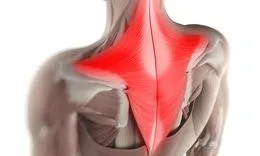
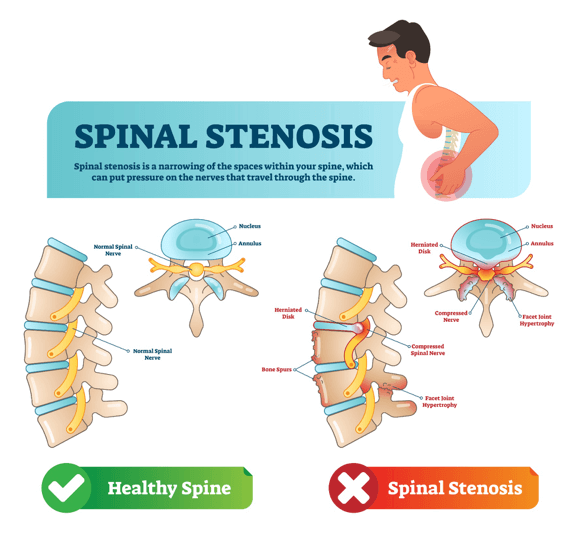
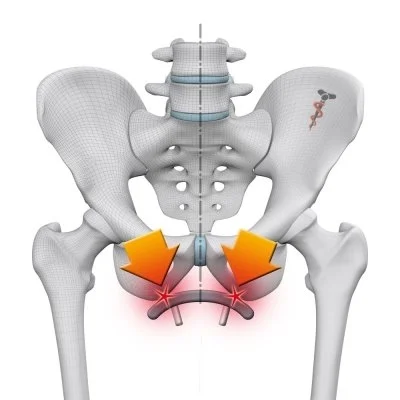
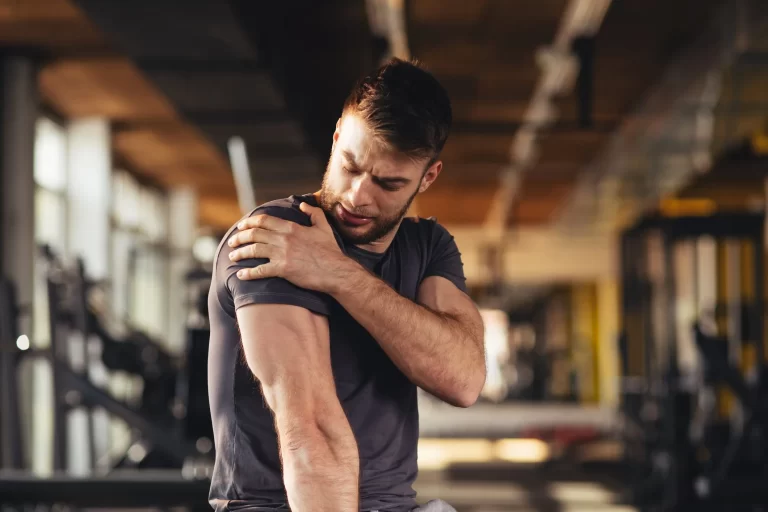
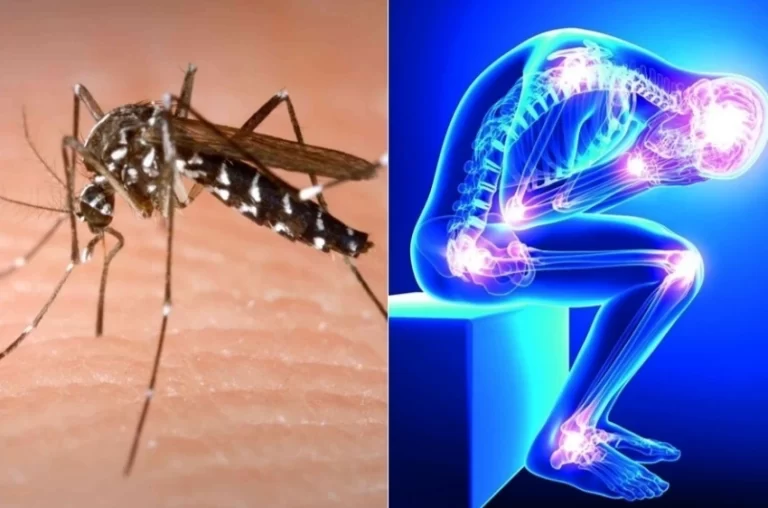
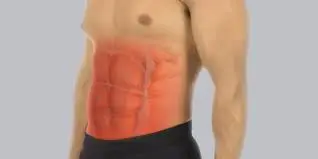

One Comment